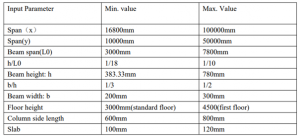1. Introduction
In today’s complex and ever-changing field of civil engineering, there are numerous factors involved in the design, analysis and construction of buildings, of which the selection and modeling of structures is a crucial aspect. Frame structures have significant advantages in the field of civil engineering, its strong structural stability, flexibility and economy etc. make frame structures ideal for a wide range of building and infrastructure projects, so it is necessary to build a model for frame structure engineering and that’s the reason why I chose frame structures.
2. Purpose and Scope
The intention of choosing frame structure is to understand the system of frame structure because many buildings can be constructed with frame structure such as multi-storey houses, hotels, office buildings, schools, etc. My aim is to allow builders to have a flexible option of choosing the frame structure as the main structure in the design to better meet the needs of different types of buildings. The aim is to provide a generic and adjustable model so that architects and design teams can freely adjust parameters such as span, floor height, beam height, beam width, slab thickness, column cross-section dimensions, and foundation depth according to the requirements of a specific project, in order to achieve precise control over the overall form and structural performance of the building.
3. Intended Use and End-Users
Intended use is to serve as a knowledge representation aiding in the development of parametric models, specifically designed for application in structural analysis.
as a tool for knowledge representation to aid the development of parametric models for structural analysis. This means that the framework aims to provide a systematic set of methods and tools to help designers and engineers to optimize the building design and structural analysis process by precisely defining and tuning structural parameters to meet specific design and performance requirements through parametric design methods.
Intended end-user: designers and engineers involved in the design process This includes architects, structural engineers, and other professionals involved in the creation, analysis, and optimization of building structures, who need to have a comprehensive knowledge of framed structures in order to make informed decisions in project design.
4. Input Parameters
The specific parameter values can be seen in Figure 1.

Final presentation of structure which is modelled in dynamo is shown in Figure 2.

Downloadable Content
Full Report: Jianwen Wang